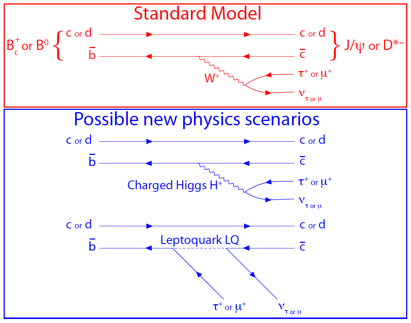Measurement of R(J/ψ): the ratio of branching fractions between Bc+→J/ψτ+ντ and Bc+→J/ψμ+νμ using τ+→ μ+νμ ντ decays.
[R(J/ψ) = 0.71±0.17±0.18]
Today, at the open session of the Large Hadron Collider Committee, LHCC, the LHCb collaboration presented the result of a new measurement of the ratio of branching fractions, R(J/ψ), between Bc+→J/ψτ+ντ and Bc+→J/ψμ+νμ using τ+→ μ+νμ ντ decays. The result that was reported is approximately 2 standard deviations from the Standard Model (SM) expectation. Furthermore, an evidence of about 3 standard deviations for the semileptonic decay of charmed-beauty mesons including τ leptons was announced for the first time.
This result must be interpreted in the global picture of extensive tests of so-called “lepton universality”. This nomenclature comes from the fact that in the SM all charged leptons, such as taus (τ) or muons (μ), interact with identical strength (or, in physicists’ language, have the same “couplings”). However, mass differences between various leptons play a role which must be accounted for when performing calculations of interaction rates. In particular, the τ is much heavier than the μ lepton, and this leads to a SM prediction for the ratio R(J/ψ) substantially smaller than unity, between 0.25 and 0.28.
A programme of measurements of lepton flavour universality with τ leptons in the final state is being performed by the LHCb, BaBar and Belle collaborations. The most recent results were reported by LHCb for R(D*), the ratio of branching fractions between B0→D*-τ+ντ and B0→D*-μ+νμ, see the 6 July 2017 news. B0 and Bc+ mesons differ only by a quark accompanying the b quark inside a B0 or Bc+ meson, as visible in the image above. Any new physics contribution to the decay diagram as for example those sketched in the image would affect both R(D*) and R(J/ψ) ratios in a similar way.
The R(J/ψ) measurement is very challenging. Due to presence of ν leptons invisible in the detector, both decays, involving either τ or μ leptons, are observed only through the three muons. Two of them are perfectly identified as arising from the decay of a J/ψ meson. The third μ is the key addition to enable semileptonic Bc+ decays involving τ or μ leptons to be distinguished from the background.
The left hand side image shows the summary of R(D*) measurements as presented in the 6 June 2017 news. It is interesting to notice that different experiments operating either at pp (LHCb) or e+e– (BaBar, Belle) colliders, using very different experimental techniques, measure values systematically above the SM prediction. The value of R(J/ψ), 0.71±0.17±0.18, reported today and presented in the lower part of the image, is also lying above the SM prediction. (Note the different horizontal scale.)
LHCb has also found other intriguing anomalies when performing tests of lepton universality. The theoretically very clean ratios R(K) and R(K*) both show deviations from the SM prediction at the level of about 2.5 standard deviations. All these measurements were performed at LHCb using the entire Run 1 data sample, corresponding to an integrated luminosity of 3fb-1 at centre-of-mass energies of 7 and 8 TeV. Data collected in Run 2 already provide a sample of B-meson decays more than twice as large, and it will be of great importance to see whether future updates of these analyses with increased statistics will confirm the hints of discrepancies. The ability of LHCb to perform measurements using different b-hadron species, notably including the Bc meson in this case, but also the Bs meson and the Λb baryon in the forthcoming future, will play a crucial role in order to clarify the global picture of deviations from lepton flavour universality that is emerging.
Read more in the LHCb presentation, in the CERN Courier R(j/ψ) article, in the CERN Courier April 2018 review article, and in the LHCb publication.


